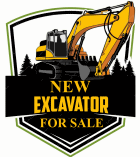There are 6 factors to take into concern when picking the right excavator:
Tonnage: When choosing an excavator, the tonnage is a necessary specification to consider. An excavator's increased weight indicates increased stability, which permits an increase in the affiliated digging depth.
Type of attachments: It’s critical to understand your job so you can be sure you’re picking the right attachments for your machinery. With a vast range of bucket sizes and kinds, along with attachments like hydraulic hammers and grapples, the attachments you select set the podium for how well you carry out your job.
Engine type: The 2 major types of excavator engines are diesel and electric, and while most of the excavators you’ll find on the market have diesel engines, there are instances where you’ll require electric. Make certain to advise yourself of the location where you’ll be operating – if you’re in a zero-emissions construction zone, you may be required to buy electric.
Reach + digging depth: Understanding the maximum dig depth is crucial before picking an excavator, and it’s always most useful to stay on the safe side and overestimate instead of having too short a boom to reach the deepness you require. The reach, on the other hand, will come into play when deciding how far your mini excavator can dig without moving. If accessibility is not a challenge for you, it’s still adequate to go for a shorter reach because longer reaches can slow the excavation cycle duration.
Tail + cab structure: From the zero and almost zero tail swing of mini excavators up to the large tail swing of larger excavators, the tail of these machines impacts stability, mobility, protection, and accessibility. Make sure the tail swing on the excavator you’re thinking of buying matches up with your project’s necessities. Contrarily, the cab on your machine has a big effect on the operator's operating environment and protection. Canopy cabs are open designs found on mini excavators and feature a simple roof. These cabs should only be utilized when stability is optimal, with no risk of capsizing. Most other excavators come with a ROPS (roll-over protective structure) cab, which protects the driver in case of rollover and is often closed & air-conditioned.
Transport + access: While opting for the most robust excavator can be attractive, it’s important to assess how the machine will be hauled to the job site and its maneuverability within the site. Choose an excavator that fulfills your geographic and logistical requirements and can be hauled effectively to the job site.
What is the right excavator for my task?
Excavators come in a variety of sizes and with various characteristics. Discover here how to choose the right one for your job.
Picking the right machine for your excavation tasks– from small excavators to large excavators to tracked excavators, or possibly a wheeled excavator – can significantly enhance the productivity and efficiency of your task. Making sure you have the right excavator attachments to go with the machine is equally as necessary. Newexcavatorforsale.com presents a vast range of excavators and attachments tailored to your task demands.
Best for small-scale work and areas: Mini excavators. These compact machines are perfect for working in smaller-scale and tighter-spaced work conditions and help indoor tasks or sites with limited access.
Best for heavy-duty jobs: Crawler excavators. With their strong tracks, sheer weight and hydraulic power tools, these machines excel in moving heavy debris and soil, perfect for heavy-duty construction tasks and mining processes.
Best for urban expansion tasks: Wheeled excavators. With the special design of their wheels, these machines are more rapid and more maneuverable on asphalt and other flat surfaces.
Whatever your task, newexcavatorforsale.com has the ideal machine tailored to complete the job as quickly and efficiently as feasible.

